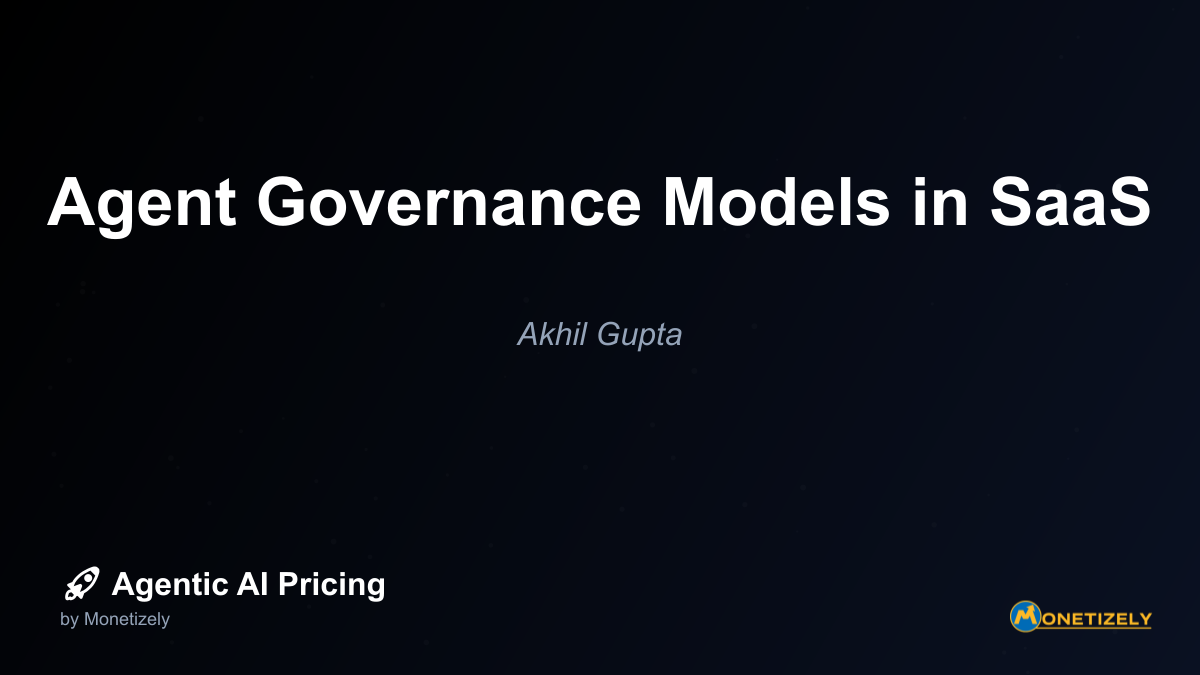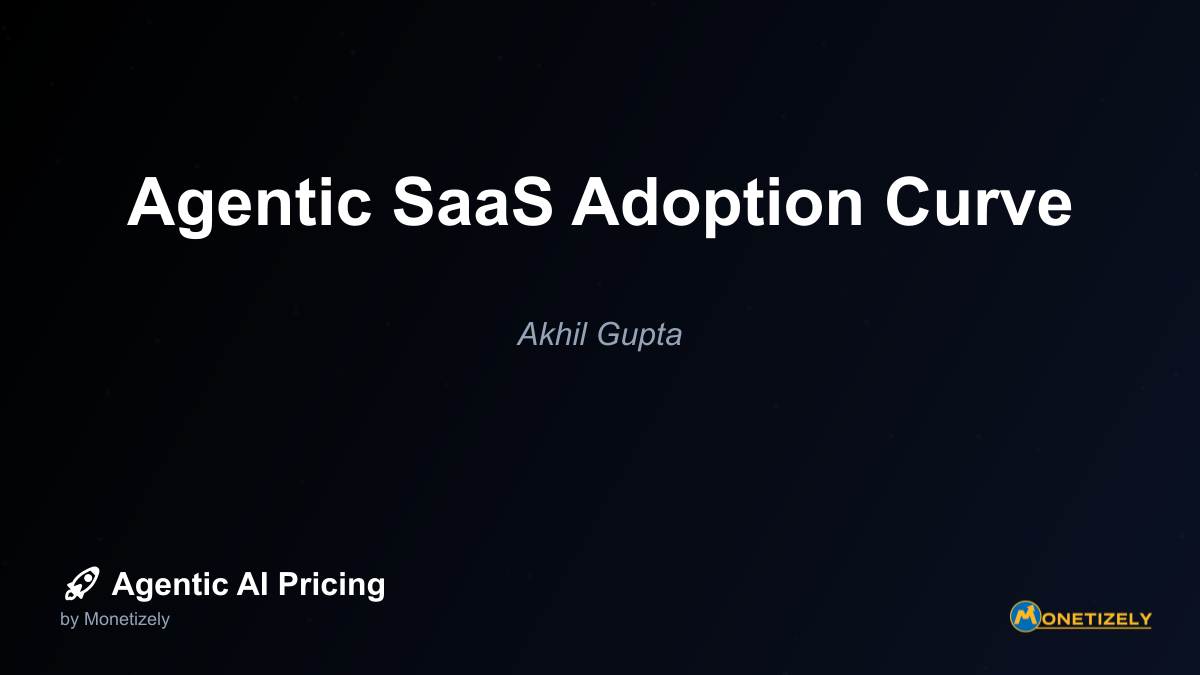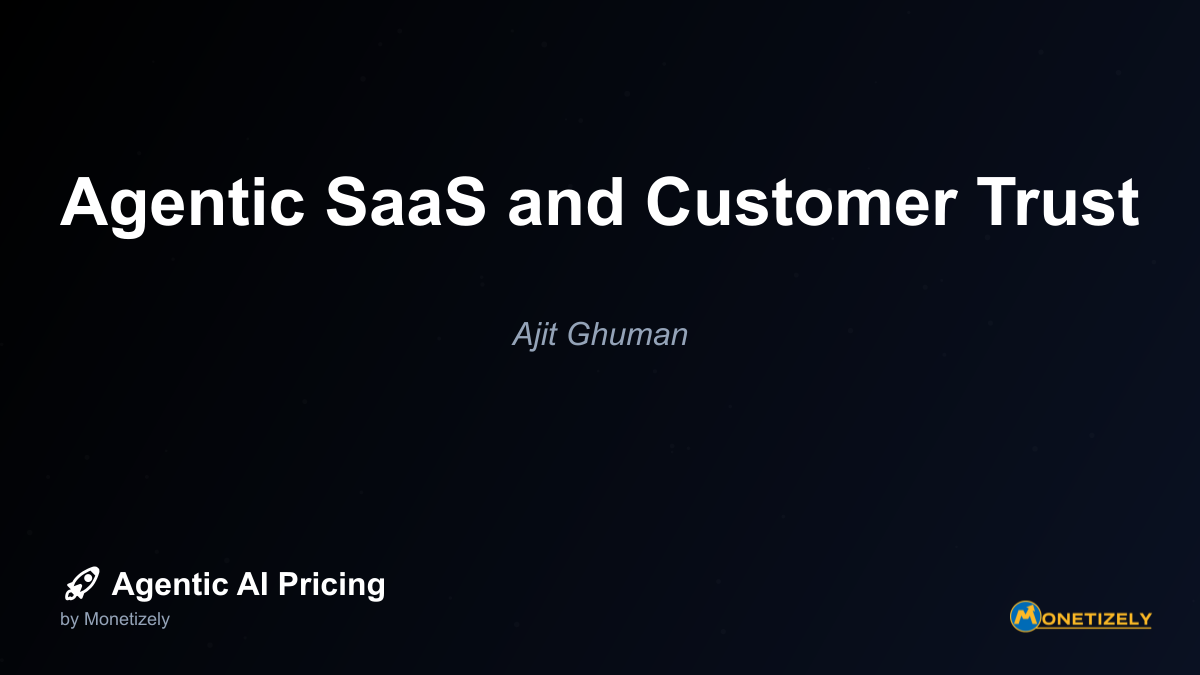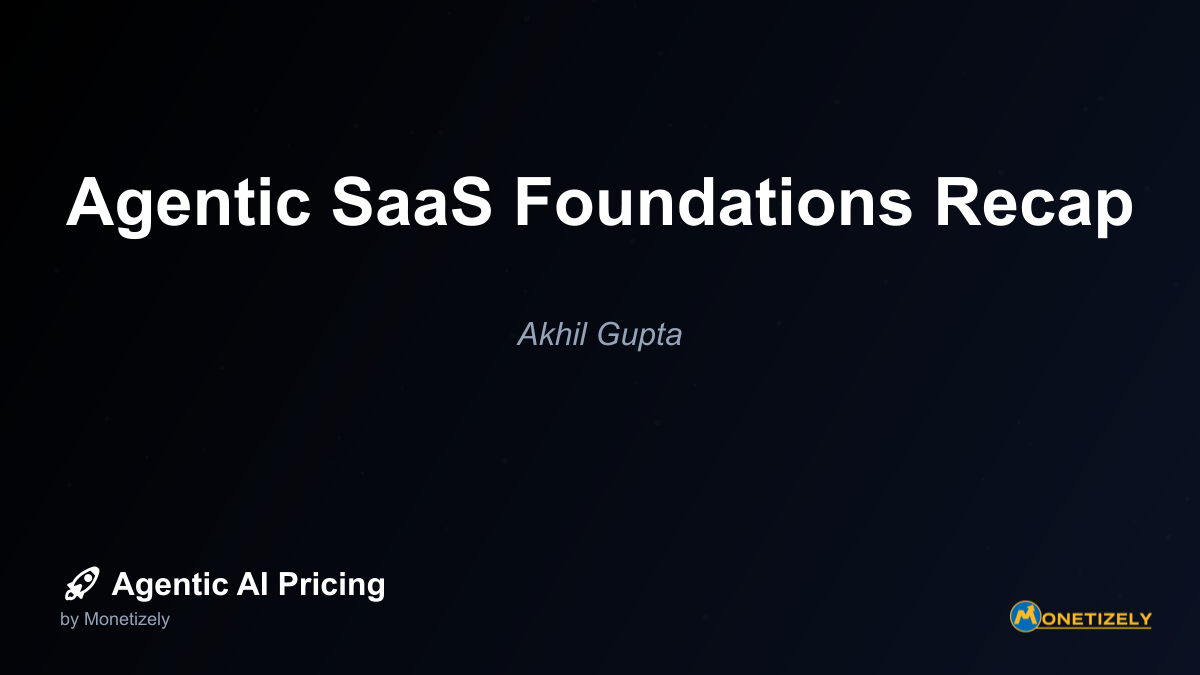· Akhil Gupta · Agentic SaaS Fundamentals · 13 min read
What Makes SaaS 'Agentic'?
AI and SaaS Pricing Masterclass
Learn the art of strategic pricing directly from industry experts. Our comprehensive course provides frameworks and methodologies for optimizing your pricing strategy in the evolving AI landscape. Earn a professional certification that can be imported directly to your LinkedIn profile.
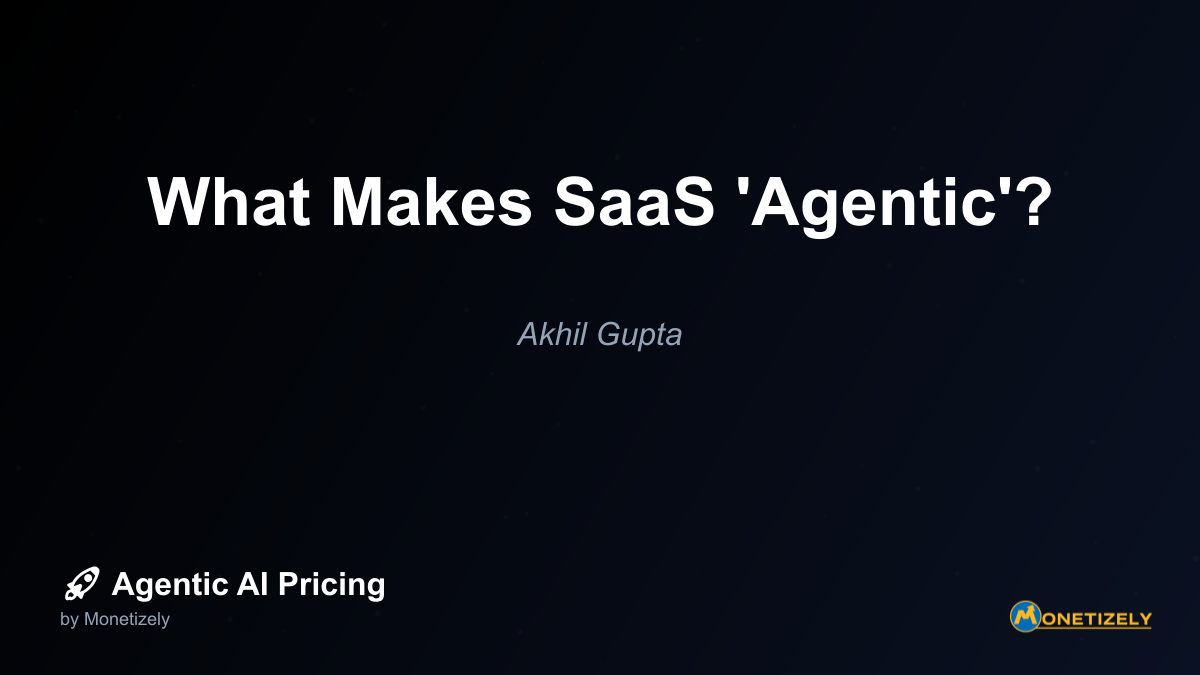
The software industry stands at the precipice of a revolutionary transformation. Traditional SaaS (Software as a Service) solutions that once disrupted on-premise software are themselves being disrupted by a new paradigm: Agentic SaaS. This emerging category represents not just an incremental improvement but a fundamental reimagining of how software delivers value. While conventional SaaS applications require significant human direction and oversight, Agentic SaaS introduces autonomous capabilities that fundamentally alter the relationship between software and its users.
What Does “Agentic” Mean in Software?
At its core, “agentic” refers to possessing agency—the capacity to act independently, make decisions, and take actions toward achieving specific goals. In the software context, agency manifests as the ability to operate autonomously with minimal human intervention while still delivering meaningful outcomes aligned with user objectives.
Traditional software, including conventional SaaS, functions primarily as a tool—responding to explicit commands and operating within tightly defined parameters. In contrast, agentic software possesses a degree of independence and decision-making capability. It can understand context, adapt to changing conditions, and initiate actions proactively rather than merely reacting to user inputs.
The term “agentic” has gained prominence alongside the advancement of artificial intelligence, particularly with the evolution of large language models (LLMs) and other AI systems capable of more sophisticated reasoning and action. However, agency in software exists on a spectrum rather than as a binary characteristic, with varying degrees of autonomy possible depending on the application’s design and purpose.
Defining Agentic SaaS
Agentic SaaS can be defined as cloud-based software that leverages artificial intelligence to perform complex tasks and make decisions with minimal human oversight while continuously learning and improving its performance. Unlike traditional SaaS applications that function as passive tools awaiting human direction, Agentic SaaS solutions actively participate in business processes, often initiating actions and making judgment calls within their domain of expertise.
More specifically, Agentic SaaS combines:
Cloud delivery model: Like traditional SaaS, these solutions are delivered via the internet, with the vendor managing infrastructure, updates, and maintenance.
AI-powered autonomy: The integration of advanced artificial intelligence enables these systems to understand context, learn from experiences, and operate with reduced human supervision.
Goal-oriented functionality: Agentic SaaS is designed to achieve specific business outcomes rather than merely performing predefined functions.
Adaptive capabilities: These systems can modify their behavior based on changing conditions, new data, or evolving user needs.
Proactive operation: Instead of waiting for instructions, Agentic SaaS can initiate processes, suggest actions, or autonomously execute tasks when appropriate.
This combination of characteristics creates software that functions less like a traditional tool and more like a digital colleague or assistant—capable of understanding what needs to be done and taking initiative to accomplish it.
The Evolution from Traditional to Agentic SaaS
The journey from conventional software to Agentic SaaS represents an evolutionary progression rather than an abrupt shift. Understanding this evolution provides valuable context for appreciating what makes Agentic SaaS distinctive.
Traditional Software (Pre-SaaS Era)
Before SaaS emerged, software was typically:
- Installed locally on physical servers or individual computers
- Purchased through one-time licensing fees with additional costs for upgrades
- Maintained and updated by the customer’s IT department
- Limited in functionality to what was initially purchased
- Isolated from other systems unless explicitly integrated
Conventional SaaS (First Wave)
The first wave of SaaS transformed software delivery through:
- Cloud-based hosting and delivery
- Subscription-based pricing models
- Vendor-managed updates and maintenance
- More frequent feature releases
- Improved accessibility across devices and locations
- Better integration capabilities with standardized APIs
While conventional SaaS dramatically improved software accessibility and reduced technical overhead, it remained fundamentally reactive—requiring explicit human direction for most operations.
Intelligent SaaS (Transition Phase)
As artificial intelligence matured, many SaaS platforms incorporated AI features that:
- Automated routine tasks
- Provided data-driven insights and recommendations
- Enhanced user experiences through personalization
- Improved search and discovery capabilities
- Enabled more natural interfaces through conversational AI
These intelligent features represented a significant advancement but typically functioned as enhancements to existing software rather than transforming its fundamental nature.
Agentic SaaS (Current Emergence)
Agentic SaaS represents the next evolutionary step, where software:
- Operates autonomously toward defined objectives
- Makes contextual decisions without human intervention
- Adapts strategies based on changing conditions
- Initiates actions proactively rather than reactively
- Learns continuously from interactions and outcomes
- Collaborates with humans as a partner rather than as a passive tool
This progression illustrates how Agentic SaaS builds upon previous innovations while introducing fundamentally new capabilities that change how organizations interact with software.
Key Characteristics That Make SaaS “Agentic”
To fully understand what qualifies as Agentic SaaS, it’s essential to examine the specific characteristics that differentiate these solutions from their conventional counterparts. While not every Agentic SaaS will possess all these characteristics to the same degree, the following elements represent the defining features of this emerging category.
1. Autonomous Operation
The most fundamental characteristic of Agentic SaaS is its ability to operate with minimal human supervision. This autonomy manifests in several ways:
- Self-directed task execution: The software can complete complex workflows without step-by-step human guidance.
- Independent decision-making: Within defined parameters, the system makes judgment calls based on available information.
- Continuous operation: Agentic SaaS can maintain functionality over extended periods without human intervention.
- Self-monitoring: These systems can evaluate their own performance and adjust accordingly.
For example, an agentic marketing platform might independently identify underperforming campaigns, reallocate budgets, adjust targeting parameters, and generate new creative variations—all without requiring a marketing manager to initiate or approve each step.
2. Contextual Understanding
Agentic SaaS demonstrates an awareness of the broader context in which it operates:
- Situational awareness: The system recognizes relevant environmental factors that should influence its actions.
- Business context integration: Decisions incorporate understanding of business goals, constraints, and priorities.
- User intent recognition: The software can infer what users are trying to accomplish beyond their explicit instructions.
- Temporal awareness: Actions account for timing considerations, deadlines, and appropriate sequencing.
A sales-focused Agentic SaaS might recognize that a prospect’s engagement patterns have changed, connect this to recent news about the prospect’s company, and adjust its outreach strategy accordingly—demonstrating contextual understanding that goes beyond simple rule-based automation.
3. Learning and Adaptation
Unlike static software, Agentic SaaS continuously improves through:
- Experience-based learning: Performance improves over time as the system accumulates experience.
- Feedback incorporation: The software adjusts its approach based on explicit and implicit feedback.
- Pattern recognition: The system identifies trends and correlations that inform future actions.
- Cross-instance learning: Insights gained from one customer can (anonymously and appropriately) benefit others.
For instance, an agentic customer support solution might learn which response styles lead to higher satisfaction for different customer segments, gradually refining its communication approach without explicit reprogramming.
4. Proactive Initiation
Traditional software waits for commands, while Agentic SaaS demonstrates initiative:
- Anticipatory action: The system takes steps before problems arise or opportunities are explicitly identified.
- Unsolicited recommendations: Without prompting, the software offers suggestions for improvements or new approaches.
- Automatic workflow triggering: Processes begin automatically when conditions warrant action.
- Resource optimization: The system reallocates resources or adjusts priorities based on changing needs.
An agentic financial analysis platform might proactively alert executives to emerging market trends that could impact their business, suggest scenario analyses, and even draft preliminary response strategies—all before being asked to do so.
5. Goal-Oriented Behavior
Agentic SaaS focuses on outcomes rather than just executing predefined processes:
- Objective prioritization: Actions are guided by their contribution to overarching goals.
- Strategy adjustment: The system modifies its approach when initial methods prove suboptimal.
- Constraint navigation: The software finds creative solutions within established limitations.
- Trade-off management: Decisions balance competing priorities based on their relative importance.
Rather than simply scheduling social media posts according to a calendar, an agentic social media management platform might dynamically adjust posting strategies to maximize engagement metrics that align with campaign objectives, even experimenting with new approaches to discover more effective tactics.
6. Natural Interaction Models
Agentic SaaS typically offers more intuitive and human-like interaction patterns:
- Conversational interfaces: Users can communicate through natural language rather than learning specialized commands.
- Intent-based interaction: The system responds to what users want to accomplish rather than requiring precise instructions.
- Adaptive assistance: Help and guidance adjust based on the user’s expertise and current context.
- Collaborative problem-solving: The software engages in back-and-forth exchanges to refine understanding and develop solutions.
Instead of requiring users to navigate complex menus and settings, an agentic project management system might allow project leaders to express goals and constraints conversationally, with the system translating these into appropriate project structures and timelines.
Real-World Examples of Agentic SaaS in Action
To move beyond theoretical concepts, examining concrete examples of Agentic SaaS implementations helps illustrate how these systems deliver value in practice. The following examples demonstrate various manifestations of agency across different business functions.
Customer Experience Management
Traditional SaaS Approach: Customer support platforms that route tickets to appropriate agents based on predefined rules, providing templated responses for common issues.
Agentic SaaS Approach: Systems that autonomously handle entire customer interactions, understanding sentiment, diagnosing complex problems across multiple products, initiating appropriate remediation steps, and even proactively reaching out when usage patterns suggest customers might encounter difficulties.
Key Agentic Elements:
- Understands customer intent beyond explicit statements
- Makes judgment calls about when to escalate to human agents
- Continuously refines communication style based on customer responses
- Proactively identifies potential issues before customers report them
Sales and Revenue Operations
Traditional SaaS Approach: CRM systems that organize contact information, track sales activities, and generate reports based on user inputs.
Agentic SaaS Approach: Revenue platforms that autonomously qualify leads, personalize outreach, negotiate with prospects (within parameters), identify cross-sell opportunities, and dynamically adjust sales strategies based on market conditions and competitive intelligence.
Key Agentic Elements:
- Prioritizes sales activities based on likelihood of success
- Adapts communication style to match prospect preferences
- Initiates follow-up sequences without manual triggers
- Learns from successful and unsuccessful sales interactions
Marketing Campaign Management
Traditional SaaS Approach: Marketing automation tools that execute predefined campaign sequences and segment audiences based on explicit criteria.
Agentic SaaS Approach: Marketing systems that independently develop campaign strategies, create and test content variations, allocate budgets across channels based on performance, and continuously refine targeting parameters to optimize return on investment.
Key Agentic Elements:
- Generates creative content tailored to specific audience segments
- Makes real-time budget allocation decisions
- Identifies unexploited marketing opportunities
- Adapts messaging based on competitive positioning
Financial Operations
Traditional SaaS Approach: Accounting software that records transactions, generates standard reports, and flags exceptions based on predetermined rules.
Agentic SaaS Approach: Financial management platforms that autonomously reconcile accounts, identify spending anomalies, negotiate with vendors for better terms, forecast cash flow with contextual awareness, and suggest strategic financial adjustments.
Key Agentic Elements:
- Detects patterns that might indicate fraud or inefficiency
- Proactively identifies tax optimization opportunities
- Learns company-specific financial patterns and preferences
- Adapts forecasting models based on changing business conditions
The Business Impact of Agentic SaaS
The transition from traditional to Agentic SaaS represents more than a technological evolution—it fundamentally transforms how businesses operate and create value. Understanding these impacts is crucial for organizations considering adoption of these technologies.
Productivity and Efficiency Gains
Agentic SaaS dramatically expands the scope of automation beyond routine tasks to include complex, judgment-intensive work:
- Time compression: Processes that previously took days or weeks can be completed in hours or minutes.
- Continuous operation: Work continues outside business hours without requiring overtime or shift coverage.
- Parallel processing: Multiple complex tasks can be handled simultaneously rather than sequentially.
- Reduced handoffs: End-to-end process execution eliminates delays from transferring work between individuals or departments.
These efficiency gains often translate to cost savings, but more importantly, they enable organizations to operate at speeds previously impossible with traditional staffing models.
Strategic Resource Reallocation
As Agentic SaaS assumes responsibility for routine decision-making and execution, human talent can be redirected toward higher-value activities:
- Creative problem-solving: Employees focus on novel challenges that benefit from human intuition and lateral thinking.
- Relationship development: More time can be invested in building and strengthening stakeholder relationships.
- Strategic planning: Leaders can dedicate greater attention to long-term direction rather than operational details.
- Innovation initiatives: Resources previously consumed by routine operations become available for experimental projects.
This reallocation represents a fundamental shift in how human capital is deployed within organizations, potentially transforming organizational structures and job descriptions.
Enhanced Decision Quality
Agentic SaaS often makes better decisions than humans in specific domains due to:
- Comprehensive data integration: These systems can consider vastly more information than humans when making decisions.
- Bias reduction: While not immune to bias, properly designed systems can mitigate many common cognitive biases that affect human judgment.
- Consistency: Decisions follow consistent logic rather than varying with mood, fatigue, or personal preference.
- Rapid iteration: Agentic systems can quickly test multiple approaches and learn from outcomes.
These improvements in decision quality can lead to better business outcomes across functions ranging from investment allocation to hiring processes.
Organizational Agility
With Agentic SaaS handling operational execution, organizations can respond more quickly to changing conditions:
- Rapid scaling: Operations can expand or contract without proportional changes in staffing.
- Market responsiveness: Changes in customer behavior or competitive actions can be addressed immediately.
- Experimentation capacity: Multiple approaches can be tested simultaneously with minimal resource constraints.
- Crisis management: Systems can rapidly reconfigure operations during disruptions without extensive replanning.
This enhanced agility provides a significant competitive advantage, particularly in volatile or rapidly evolving markets.
Challenges and Considerations in Adopting Agentic SaaS
While the potential benefits of Agentic SaaS are substantial, organizations must navigate several significant challenges when implementing these solutions. Understanding these considerations is essential for successful adoption.
Governance and Control
Balancing autonomy with appropriate oversight presents complex governance challenges:
- Decision boundaries: Organizations must determine which decisions can be delegated to agentic systems versus those requiring human approval.
- Override mechanisms: Clear processes must exist for human intervention when agentic actions need correction.
- Audit trails: Comprehensive logging of autonomous decisions becomes critical for accountability.
- Performance monitoring: New metrics and monitoring approaches are needed to evaluate agentic system effectiveness.
Developing appropriate governance frameworks requires cross-functional collaboration between technical teams, business stakeholders, and compliance specialists.
Change Management
The introduction of Agentic SaaS typically requires significant organizational adjustment:
- Role redefinition: Existing job descriptions may need substantial revision as responsibilities shift.
- Skill development: Employees need new capabilities to effectively collaborate with agentic systems.
- Trust building: Stakeholders must develop appropriate levels of trust in autonomous systems.
- Process redesign: Workflows optimized for human execution often require restructuring for agentic operations.
Organizations that underinvest in change management typically experience resistance, underutilization, and diminished returns from their Agentic SaaS implementations.
Ethical and Legal Implications
Autonomous systems raise important ethical and legal questions that organizations must address:
- Accountability frameworks: Clear responsibility must be established for decisions and actions taken by agentic systems.
- Transparency requirements: Organizations need to determine how much visibility into decision processes different stakeholders should have.
- Bias mitigation: Ongoing efforts are needed to identify and address potential biases in agentic decision-making.
- Regulatory compliance: Emerging regulations regarding AI and autonomous systems must be monitored and incorporated.
Proactive engagement with these issues helps organizations avoid reputational damage and legal complications while building trust with customers and employees.
Integration Complexity
Incorporating Agentic SaaS into existing technology ecosystems presents technical challenges:
- Data accessibility: Agentic systems require comprehensive access to relevant data across organizational silos.
- API dependencies: Autonomous operation often relies on robust integrations with multiple systems.
- Performance considerations: Real-time decision-making may create new performance requirements for supporting infrastructure.
- Security implications: Expanded system authorities may necessitate enhanced security controls.
Organizations should conduct thorough technical assessments before implementation to identify potential integration obstacles and develop mitigation strategies.
How to Evaluate if a SaaS Solution is Truly “Agentic”
As the term “agentic” gains popularity, marketing claims may sometimes outpace actual capabilities. Business leaders need practical criteria to distinguish genuinely agentic solutions from conventional software with incremental AI features.
Assessment Framework
When evaluating potential Agentic SaaS solutions, consider
Co-Founder & COO
Akhil is an Engineering leader with over 16+ years of experience in building, managing and scaling web-scale, high throughput enterprise applications and teams. He has worked with and led technology teams at FabAlley, BuildSupply and Healthians. He is a graduate from Delhi College of Engineering and UC Berkeley certified CTO.
Pricing Strategy Audit
Let our experts analyze your current pricing strategy and identify opportunities for improvement. Our data-driven assessment will help you unlock untapped revenue potential and optimize your AI pricing approach.

